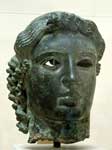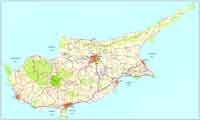.
Ancient Tamassos
The city-state prospered mainly because of its mines, from which metals (mostly copper, Cyprus' chief export in the ancient world) were extracted. However, Tamassos has managed to survive throughout the ages, despite the fact that all copper mines were exhausted, and is now believed to remain buried under the village of Politiko.

Chatsworth Head, probably Apollo.
Foundations, inhabitants, and economy
Unlike other city-states on the island, there is no precise information from either history or tradition, concerning the establishment of Tamassos as a human settlement and later as an important trade city. The oldest known reference of Tamassos which proves its existence is found in Homer's epic poem of the Odyssey (A, 184). Particularly, a man called Efstathios (Eustace) talks of a Cypriot town:
"…There is a town in Cyprus, "Temesi" according to some, that is also copper-bearing…"
The correlation between a town in Cyprus called "Temesi" and copper lead to the assumption that Homer was actually referring to Tamassos.
The area of Tamassos itself was in fact home to a number of small farmer settlements, which were replaced by the city following the discovery and manipulation of the copper mines. Thus copper became the heart of economy in Tamassos in the centuries which followed. Studies of the archaeological artifacts suggest that the region was inhabited since Prehistoric times and, more specifically, since the Chalcolithic Age. Even so, villages belonging to the wider region of Tamassos (such as Kampia, Margi, Kotsiatis, and Mathiatis) were of a dense population ever since the Early Bronze Age. The population of central Tamassos increased significantly following the exploitation of the area's copper mines. Evidently, the tombs and copper-processing installations which were discovered in the area date back to the Late Bronze Age.
Other writers such as Claudius Ptolemy and Stefanos Byzantios also speak of Tamassos. The latter describes the city as "mesogeia" (of the midlands) with copper of excellent quality. Yet it is the fact that Tamassos was located in the middle of the island and had no port which hindered it from becoming a major trading post such as Salamina (otherwise known as Salamis) and Pafos. The city also lacked the cosmopolitan character of the island's coastal cities. In truth, Tamassos resembled an "industrial" city with of mines and workshops, though it had without doubt developed in both agriculture (due to the surrounding fertile land) and stock-breeding. The agriculture of the area was also boosted by the fact that one of Cyprus' most important torrential rivers, the Pediaios, and other tributaries, made the soil fertile.
The two royal tombs of Tamassos are proof of the city's wealth during the Archaic era. For these to be constructed a considerable amount of money was required. Therefore, the tombs suggest financial prosperity.
The influence of the Greeks
The Greek influence in the region can be proved by the evident worship of Greek deities. Furthermore, there seem to have been many interactions between Tamassos and the Greeks. For example, the King of Tamassos, Pasikypros, is said to have sold his kingdom to the Phoenicians of Kition for a price of 50 "talents". Having received this amount of money, the King went to spend his last days in Amathus. Athenaeos claims that Alexander the Great gave the same city to Pnytagoras, the King of Salamina, as he had assisted him with the invasion and capture of Tyros.
Moreover, the reconstruction of Aphrodite's temple, and perhaps of other public buildings, is observed during the beginning of the Hellenistic years. It is assumed that there was an alteration to the city character and political structure, not to mention that new public buildings must have been constructed.
During the reign of the Hellenistic Empire, Greeks from various places of the empire came to live in Tamassos. One of these people was Aspendios from Asia Minor.
After the appearance and spread of Christianity to most of southern Europe, Tamassos became one of the first Greek Orthodox dioceses (Bishopric Seats) of Cyprus. The presence of its two first Bishops, St Herakleidios and St. Mnason, was prominent.
The archaeological site
No major archaeological excavations have been conducted in the area of Tamassos because the centre of the town, which is believed to have been the location of various public buildings and shrines, is thought to be under the village of Politiko and the nearby Greek Orthodox monastery of "Agios Hrakleidios".
Sporadic excavations (specifically between 1970 and 1990) in the outer area resulted in the discovery of many artifacts as well as parts of the original city dating from the Archaic, Classical, and Hellenistic eras. The visible sections of this large and important archeological site also include the site of the temple of Aphrodite, the two majestic royal tombs, and other graves.
Fortifications which surrounded the city during the Archaic period have also been unearthed, as well as, copper-processing installations, clay and stone statuettes, and various oblation-vessels, censers, and oil lamps. A limestone altar was found nearby Aphrodite's temple as well as a temple devoted to Kiveli (the Mother of Gods). The latter was discovered alongside an epigraphic testimony regarding the goddess' worship. In addition, there are various literary references proving the worshipping of Apollo, Aesculapius, and Dionysus.
Recently six life-size limestone sculptures were discovered, of which two represented sphinxes and four represented lions in a crouching position. Apparently, the sculptures originate from the 6th century BC. when Egyptian rule was present on the island. The findings are currently on display at the Cyprus Museum in Nicosia.
The necropolis and the tombs
North-east of Aphrodite's temple lies the necropolis of Tamassos. In addition, three cemeteries are located in the region. One dates back to the Copper / Bronze Age, another to the Archaic period, whilst the third belongs to the Hellenistic era and the times of Roman rule. Most of the Bronze Age cemetery is probably close to the Lambertes barrow (south-east of the Politiko village). South-west of the "Agios Herakleidios" monastery, a tomb belonging to the Middle Bronze era was dug up in 1963. Yet another tomb from the latter part of the Bronze Age was excavated south-east of the monastery, in the region between the present-day nunnery and the Lambertes barrow. The Archaic era cemetery is located, south-west of the village, between the region's two rivers, of which one is the torrent Pediaios, which waters most of Nicosia District and particularly the fertile (and now Turkish-occupied) area of Mesaoria. The Hellenistic/Roman cemetery is found on a slope north-west of Politiko, where the "Agios Mnason" monastery once existed. Many shrines also seem to have existed around the ancient city of Tamassos. This can be proven by the presence of the Archaic earthen statue and the famous bronze statue of Apollo found in the area. Nowadays the two monasteries of St. Herakleidios and St. Mnason are believed to be important monuments of the region.
The decline of Tamassos
Tamassos is referred to as a city of Cyprus until the 10th century. Yet by that time the city had already declined. The mines were abandoned after their exhaustion, and the economy was destroyed. Much later on, the city was replaced by small settlements such as Politiko and Episkopeio. The name "Politiko" refers to the brilliant ancient city it has replaced, whereas the name "Episkopeio" is reminiscent of Tamassos's old diocese. "Ergates" has been thus named because it is the area where the mine workers lived, while "Pera Orinis" is named because it is opposite Politiko ("pera" being Greek for "yonder"), and because it is located in a hilly area ("oreinis" being Greek for "of the mountains" as opposed to the village "Pera Chorio Nisou" which is in the lowlands). It is believed that these settlements are a continuation of ancient Tamassos and that the inhabitation of this region has thus been continuous from the ancient Prehistoric times until present times.
Tamassos Today
Tamassos is now a local term used to describe the area in which the villages of Psimolofou, Episkopeio, Pera Orinis, Ergates, Politiko, Kampia, Analyontas, and Kapedes are located. For the past few centuries the villages have developed from being poor agricultural villages housing some 10 families to becoming villages consisting of 1000 inhabitants. Pera Orinis and Politiko retain much of the older buildings of the older settlements at the centre of the villages, which are deemed to be of high cultural significance. Highlights of these include the church of Panagia Odigitria, the Old Mill, the Parthenagogion and Arenagogion, as well as the recently restore chapel of St George of Pera Orinis, and the famous Tombs of the Kings of the village of Politiko.
The TAMASSOS Cultural Association
The TAMASSOS Cultural Assciation was established in 1989 by the 8 communities that constituted the ancient kingdom of Tamassos. After having been neglected for a few years, it becoming active once more in 2000. The association currently strives to bring the inhabitants of Tamassos together and to organise certain cultural activities during the year. Of these events the most important is considered to be the so-called "TAMASSIA", which takes place every year by the end of September and lasts for approximately two weeks. These event includes a cross-country bicycle ride within Tamassos, a seven-a-side soccer league, a backgammon contest, a "Pilotta" contest ("Pilotta" being a type of card game), Target Shooting Games, theatrical performances, and camping. The "TAMASSIA" are believed to make participants appreciate their cultural heritage. The Cultural Association also regularly issues a free newspaper, through which the activities of both the TAMASSOS Cultural Association and the separate communities are promoted.
References
Links
Archeological Sites: Tamassos - Department of Antiquities of the Republic of Cyprus.
[1] Archeological findings of Tamassos at the British Museum.
Rare Cypriot Sculptures found in Tamassos - archeology.org, a publication of the Archaeological Institute of America.
tamassos.org - History and culture of the area; list of churches etc.
collection - Harvard Semitic Museum, Harvard University
Weapons, Tools and Ritual Remains - Ashmolean Museum, Oxford.
Information and photos of Tamassos.
|
Archaeological sites , ancient cities in Cyprus Aetokremnos | Alassa | Apliki | Choirokoitia | Chytri | Gialia Monastery | Enkomi | Kalavasos-Tenta | Kastros | Katalymata ton Plakoton | Klimonas | Kourion | Kyrenia ship | Lapithos | Marion | Marki Alonia | Mnemata Site | Paphos | Salamis | Shillourokambos | Soli | Tamassos | Tombs of the Kings (Paphos) | |

| Ancient Greece
Science, Technology , Medicine , Warfare, , Biographies , Life , Cities/Places/Maps , Arts , Literature , Philosophy ,Olympics, Mythology , History , Images Medieval Greece / Byzantine Empire Science, Technology, Arts, , Warfare , Literature, Biographies, Icons, History Modern Greece Cities, Islands, Regions, Fauna/Flora ,Biographies , History , Warfare, Science/Technology, Literature, Music , Arts , Film/Actors , Sport , Fashion --- |
Retrieved from "http://en.wikipedia.org/"
All text is available under the terms of the GNU Free Documentation License

